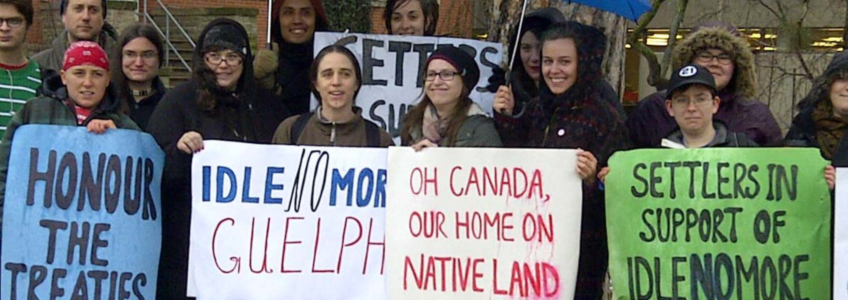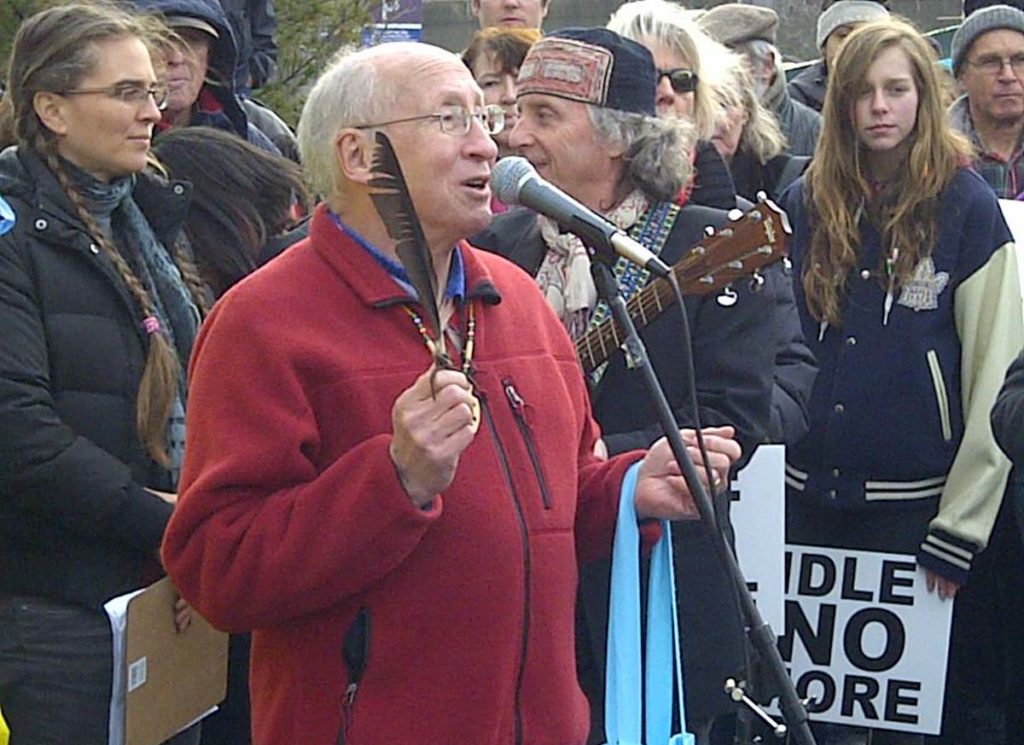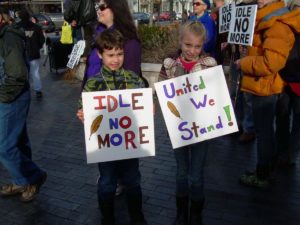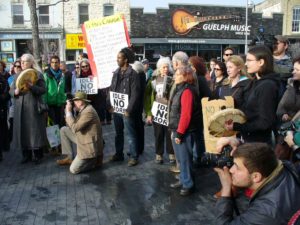Ten Years Later – Idle No More Movement made history in Canada and Guelph in 2013

Banner: Photograph taken during the Idle No More Rally which assembled at the University of Guelph’s Branion Plaza and marched to St. George’s Square on 11 January 2013. The group is photographed in front of Zavitz Hall at the University of Guelph. 2022.3.11, Guelph Museums
Ten years ago, in 2013, the Idle No More movement marked a turning point in modern Indigenous history in Canada. The grassroots movement began in November 2012 and quickly swept across Canada, organized largely through social media. It changed the discourse about Indigenous people and empowered a new generation of organizers in Canada and in Guelph.
Inspired by Threats to the Environment and Indigenous Rights
The Idle No More movement arose to protest Bill C-45, the 457-page omnibus bill through which the federal government made changes to over 60 statutes including the Environmental Protection Act, Fisheries Act, Navigable Protection Act, and Indian Act – without consultation. Many considered these changes a threat to the rights of Indigenous peoples and the environment. Thousands of Indigenous and non-Indigenous people banded together to oppose these changes.
Idle No More began with four Saskatchewan women – Sylvia McAdam, Jessica Gordon, Nina Wilson and Sheelah McLean – who held teach-ins on the legislation in November 2012. The movement quickly grew on social platforms. Soon demonstrations, teach-ins, and round dances were occurring across Canada. The events had an uplifting, celebratory focus with dancing, singing, and drumming. Inspired by events in Canada, Idle No More events popped up in the United States, United Kingdom, France, New Zealand, Greenland, and other parts of the world. The scenes were initially being broadcast on APTN (Aboriginal Peoples Television Network), but not on mainstream media. Finally, late in December, the mainstream media took notice that hundreds of people were taking to the streets in protest.
Stirrings in Guelph
In December 2012, a small group of people gathered at a café in downtown Guelph to organize Idle No More events in Guelph. Jan Sherman, James Gordon, Paul Smith, Norah Chaloner, Donna Jennison, and others, began planning local actions that would lead to one of the largest demonstrations at Guelph’s City Hall in many years – inspiring a lasting social legacy. Social media was a powerful tool for mobilization. Eventually, a number of local organizations either helped organize or publicize the events, including the Guelph-Wellington Coalition for Social Justice, Council of Canadians-Guelph, OPIRG-Guelph, Grand River Métis Council, the University of Guelph Aboriginal Students Association, Aboriginal Resource Centre, and Anishnabeg Outreach.
Momentum for Meeting of Indigenous Leaders with Prime Minister
National organizers called a series of National Days of Action during December 2012 and January 2013. The movement continued to grow. On December 11, Attawapiskat Chief Theresa Spence began a fast in a teepee on Victoria Island in Ottawa, which became a focal point for political action.
Many called for a meeting of the Prime Minister and Indigenous leaders. On 11 January 2013 a delegation of Indigenous leaders, including the Assembly of First Nations national chief Shawn Atleo, met with the Prime Minister Stephen Harper.
Also on 11 January 2013, about 50 Idle No More demonstrators rallied at Brannion Square at the University of Guelph and gathered in downtown Guelph in support of the national movement. The supporters marched down Quebec and Norfolk Streets before gathering in front of City Hall.
On 12 January 2013, large Idle No More protests were held across the country and in Guelph, Ontario.
Overwhelming Support in Guelph

Bruce Weaver speaking during the Idle No More Rally at Market Square outside City Hall, 13 January 2013. 2022.3.18, Guelph Museums
On 25 January 2013, then federal environment minister Peter Kent visited the Cutten Fields Golf Club on College Avenue, and approximately 75 Idle No More demonstrators gathered outside. Kent spoke to an indoor crowd of local dignitaries, water experts, activists, and entrepreneurs about the federal government’s environmental initiatives. Kent talked briefly with the assembled protesters regarding their concerns about Bill C-45 and C-38.
Inspiration for Guelph’s Indigenous Community
Inspired by the success of these local events, Guelph organizers sponsored events throughout 2013. As it did across Canada, the energy of Idle No More empowered Guelph’s Indigenous community. The organizers teamed up with other groups, including the University of Guelph Aboriginal Students Association, and held events throughout the year, including an April panel discussion at the University, a vigil at City Hall for Have a Heart Day on February 14, and a first anniversary of Idle No More in December at City Hall. A reinvigorated celebration of National Aboriginal Day took place in Royal City Park on June 21, for the first time in several years.
The mobilization of Guelph’s Indigenous community and supporters in 2013 was a precursor to the gathering of hundreds of marchers in June 2021 at the Basilica of Our Lady Immaculate, which honoured the children buried in unmarked graves at Indian residential “schools.” Hundreds of childrens’ shoes were placed on the basilica grounds as a memorial to the lost children. This reflected the nation-wide emotional outpouring resulting from the tragic revelations of unmarked graves of Indigenous children at Kamloops and other residential school sites across Canada.
Social media was a major organizing tool in Guelph in 2021, as it was in 2013. An “Idle No More Guelph” Facebook group got things going in 2012-13. That Facebook group, now called “Indigenous Guelph and Friends” has 750 members. The group, also active on Instagram and Twitter, played a large role in facilitating organization of rallies in 2021.
Inspiration for Change
Much has changed in the discourse about Indigenous people in Canada and Guelph in the last ten years. The Truth and Reconciliation Commission, the National Inquiry into Missing and Murdered Indigenous Women and Girls, change in institutions like the City of Guelph and University of Guelph, the creation of the Sacred Fire Circle in Royal City Park, the start up of the Waterloo-Wellington office of the Southwest Ontario Aboriginal Health Access Centre, and more. Yet, so much more needs to change to improve Indigenous lives, even though the change over 10 years is undeniably remarkable. Idle No More was a force in that transformation. Reconciliation remains a dream more than a reality, but it is a vivid and inspiring dream.
Authors and Contributors:
Paul Smith, James Gordon, Jan Sherman, Norah Chaloner, Bruce Weaver, Donna Jennison, Dawn Owen
Research Resources:
Guelph Mercury, “Idle No More a Presence at Peter Kent’s Visit to Guelph”
https://www.guelphmercury.com/news-story/2793983-idle-no-more-a-presence-at-peter-kent-s-visit-to-guelph/
Accessed 22 February 2022
Guelph Mercury, “Idle No More Rally Draws Large, Peaceful Crowd to Downtown Guelph” https://www.thestar.com/news/canada/2013/01/11/social_media_helps_drive_idle_no_more_movement.html
Accessed 22 February 2022
CBC News, “Idle No More Protests go one after PM meets AFN Leaders”
https://www.cbc.ca/news/canada/idle-no-more-protests-go-on-after-pm-meets-afn-leaders-1.1325096
Accessed 22 February 2022
Guelph Mercury, “Two hundred and fifteen Indigenous children: Yet another reckoning. Real reconciliation with First Nations, Inuit and Métis is Canada’s historic task for coming decades”
https://www.guelphmercury.com/opinion-story/10421326-two-hundred-and-fifteen-indigenous-children-yet-another-reckoning/
Waterloo Region Record, “Idle No More Movement comes Saturday to Guelph”
https://www.pressreader.com/canada/waterloo-region-record/20130108/281865820818642
Accessed 22 February 2022
Toronto Star, “Social Media Helps to Drive Idle No More Movement” https://www.thestar.com/news/canada/2013/01/11/social_media_helps_drive_idle_no_more_movement.html
Accessed 22 February 2022
CBC, Unreserved, “How Idle No More transformed Canada. Co-founder says the movement was like a ‘bullhorn,’ bringing attention to Indigenous rights concerns”.
https://www.cbc.ca/radio/unreserved/idle-no-more-reconciliation-1.6663310
“The Winter We Danced: Voices from the Past, the Future, and the Idle No More Movement.”
The Kino-nda-niimi Collective. ARP Books, Winnipeg MB Canada.
https://arpbooks.org/product/the-winter-we-danced/
“Government and Indigenous Protest: An Analysis of the Response to Idle No More – Ignored No More.” Danette Starblanket, PhD Dissertation, University of Saskatchewan, Saskatoon. 2022.
https://harvest.usask.ca/handle/10388/14384





